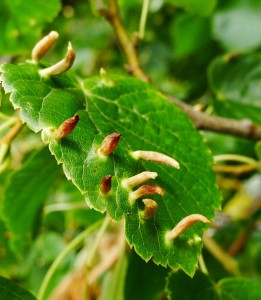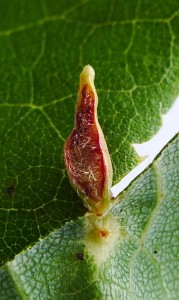Continuing our look at galls caused by mites, Figs 1 and 2 illustrate two nail or bugle galls caused by eriophyoid mites on common lime, Tilia x europaea, on campus.
These galls are much larger than those caused by mites on acers, and several on a leaf are an impressive sight. The key in Redfern et al. (2002) separates the two species thus: over 8mm tall with pointed tips = E. tiliae/ about 5mm tall with rounded tips = A. lateannulatus.
Interestingly, the former is found on large-leaved lime Tilia platyphyllos, and the latter on small-leaved lime T. cordata: and both occur on the hybrid common lime. These galls have a similar structure and their mites have a similar lifecycle to those on acers discussed above; they are pouch galls, yet females of E. tiliae only produce one gall (although sometimes two galls appear from the same base, Fig 3).
Their galls are also tougher, with thick walls and lignified sheaths around the vascular strands, and the nutritive cells contain several large polyploid nuclei. Fig 4 shows a section of an E. tiliae nail gall from campus; that it is hollow is clear, and this one is full of hairs.
Some say that all nail galls are hairy inside (Redfern et al. (2002) use this as a key characteristic of the species), others that galls only gain these hairs after they have been abandoned. Anyway, mite populations of up to 200 can be sustained by each of these galls.
Like the mite galls on acers, the species of lime mite gallers are rather uncertain, with the supplement to Redfern et al. (2002) (available here) stating ‘the determination of mite galls is uncertain…the identity of Tilia mites needs to be checked by an expert.’ Bearing that in mind, there may be some more Tilia gall mites on campus, as several other mites produce small pustules on limes. For example Eriophyes exilis (Fig 5, at Waddesdon Manor, near Aylesbury) produces a c 2mm raised bump in the angle of veins, I’ll be looking out for it on campus.





